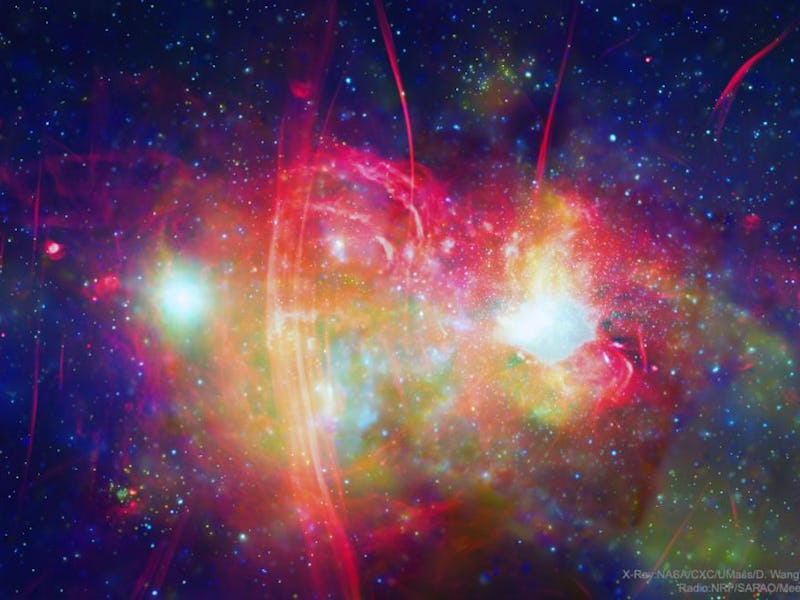This is when scientists could release the first image of the Milky Way's black hole
Scientists are currently working on capturing Sagittarius A* in its full glory.

An image released Monday brought a massive black hole and its violent jets into focus.
But yet again, it wasn’t our own galaxy’s black hole. It was Centaurus A, some 12 million light-years away from our Solar System.
That may soon change.
Using the Event Horizon Telescope (EHT) — the same telescope used to capture the first-ever image of a black hole — scientists are currently working toward capturing the first image of the Milky Way’s supermassive black hole, Sagittarius A*.
And when Inverse talked to Event Horizon Telescope astronomers, they suggested we could finally see our galaxy’s behemoth by the end of the year.
Here’s the background — In April 2019, a group of more than 200 astronomers from all over the world unveiled the very first image of a black hole. The EHT team compiled the image from eight telescopes on five continents working over an observing period of seven days.
The black hole is located at the center of the galaxy Messier 87 (M87). M87 is located about 55 million light-years from Earth and weighs in at about 6.5 billion times the mass of the Sun, much larger than Sagittarius A*.
Sagittarius A*, for comparison, is located about 27,000 light-years from us and is 4 million times the mass of the sun. Scientists know that it’s there from its influence on its surrounding environment, but they’ve never seen it directly. For instance, the star S0-2 is on a long, 16-year elliptical orbit around the black hole.
The bright part in the center is the region surrounding Sagittarius A*. However, the event horizon itself has never been imaged.
Geoffrey Bower, a project scientist at the Event Horizon Telescope Collaboration, tells Inverse that while Sagittarius A* is “1,000 times smaller” than M87, it’s also “1,000 times closer” so “it should appear very similar in the sky as M87.”
“We'd very much like to see that same kind of image and demonstrate that that effect that we see in M87 is present in Sagittarius A*,” Bower says.
Most large galaxies have a black hole at their center, and the size of the black hole largely depends on the size of the galaxy itself.
At the outset of the experiment, EHT astronomers hoped to capture an image of Sagittarius A*. But it’s proven elusive for two reasons:
2. Dusty plasma in space
A lot is standing between us and Sagittarius A* — some of which radio telescopes can’t easily see through.
“We're looking through the plane of our galaxy, and in the plane of our galaxy, there is some material called turbulent plasma,” Bower says. “It’s essentially cloudy ionized gas that blurs the image.”
Scientists captured the very first image of a black hole, providing direct evidence that these cosmic beings do exist.
Plasma is essentially what happens when ions and electrons don’t form atoms but instead exist in an ionized gas state. That could cause things to look a little murky when starting down towards the center of the galaxy.
This ionized gas will result in a fuzzy structure with very little detail in it at longer wavelengths.
The researchers are working towards shorter wavelengths to create a more focused image to minimize the blurring effect.
1. M87 black hole size comparison
The second factor that the EHT scientists have to consider is that the orbital timescale for gas around the Milky Way’s black hole is much shorter since it has a smaller mass and a smaller diameter.
The M87 image took about eight hours of observations to capture the black hole from different angles.
“Now imagine that happening while the source may be changing at the same time,” Bower says. “Some distortion of the image can occur as a result of motions of the gas around the black hole.”
When will Event Horizon Telescope images of Sagittarius A* be released?
The researchers have been paying closer attention to Sagittarius A* to characterize the degree of its variability and produce the clearest image of the black hole.
Michael Janssen, a researcher at the Max Planck Institute for Radio Astronomy in Bonn, Germany and a black hole imaging team member, compares it to trying to capture an image of a moving target.
“The source is actually very variable — it varies a lot in the duration in which we're observing,” Janssen tells Inverse. “If you take a picture of something that is like a running child, or a running dog, it will be blurry, so we need to take that effect into account when we take the image.”
According to Bower, the team is currently developing tools to help them overcome those challenges, but they expect the image to be ready by the end of this year.
“And then we have multiple years of additional observations with increased capabilities, so this is all really just the beginning for the Event Horizon Telescope,” Bower says.